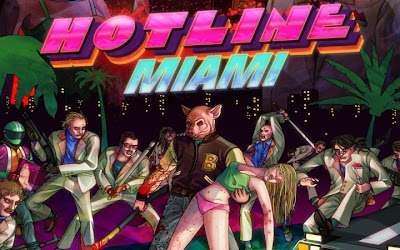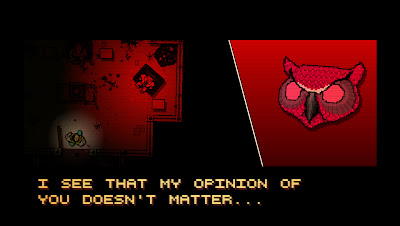I'm not going to pretend that I can sum up what Hotline Miami is better than the game's publisher Devolver Digital, so here it is straight from the horse's mouth:
Gamers will step into the neon-soaked underground of 1980s Miami as bizarre messages on your answering machine seem to be urging you to commit terrible acts of violence against a nameless group of armed thugs. Overflowing with raw brutality and skull crushing close combat, Hotline Miami demands sharp reactions and a creative approach to navigate a gauntlet of 20 multiscreen missions. Wield 35 different weapons, collect 25 game-altering masks, and unveil a dark, surreal storyline that will force you to question your role in this murderous spree.
So there you have it: a nice basic summary of what this game is all about. Hotline Miami that takes a very barebones story and wraps it around a few simple gameplay mechanics that have some depth in execution, and then presents them all with a perfectly tuned aesthetic that marries each element together into a cohesive package. Three basic ingredients: Story, game, and presentation combined to make one game that is greater than each of those parts.
The Story in Hotline Miami takes place over the course of spring and summer of 1989. The majority of it follows the same pattern: phone message, killing spree, brief encounter with a "friend" at the video rental or pizza parlor. Most every day is like this. Occasionally your character will meet in a darkened room with three other masked individuals who'll menacingly question him about what he's doing. Somewhere around the midpoint of the game, it starts to get more and more clear that your character is becoming mentally unhinged or maybe has been all along. How much of the story is really happening is unclear after playing through it once, and towards the end you'll wind up seeing some things that seem to directly contradict portions of the game you'd previously played through. When it's done you'll probably have more questions than answers which really works in service of the story. I'm not sure if there's any real depth to the story, or if it is merely the illusion of depth, but they've managed to make it so that one is just as good as the other.
The game plays mostly as a tactical twin-stick shooter. Make no mistake though, charging in blindly guns a' blazing will just get you killed most of the time. You'll need to sneak around and dispatch enemies quietly with melee attacks for as much of each level as possible, since melee kills won't draw attention like guns do. Unless you're actively holding shift down and moving the cursor towards the edges of the screen, your field of view will be pretty limited. This gives the action kind of an up-close immediacy, forcing you to focus on one room at a time. Punches, opened doors, and thrown weapons can knock enemies down, taking them out of the action briefly and also making them vulnerable to gruesome execution attacks. Melee weapons are mostly one hit kills, and guns usually kill in one or two hits as well. You're as vulnerable as the enemy is, so you'll die a lot, but respawns are instant, allowing you to jump back in the action quickly.
For the most part, the game plays really great. It gives you a limited toolset and then allows you to use it in an almost sand-box fashion to plan your rampage across each level. It's very tactical and precise, but still occasionally devolves into a furious firefight or all out melee that'll have you improvising like mad in order to survive. It's challenging and unforgiving, but the penalty for failure is basically non-existent, so you won't get frustrated often. That's not to say the game is without any problems, though. The mask-powers are a cool idea but in practice you'll wind up sticking to one or two masks for the majority of the game. Boss fights are a frustrating low point that wind up requiring sheer luck and repetition in order to get through. Enemy AI is also somewhat unpredictable, with some enemies spotting and shooting you from off screen while others don't even flinch when you've busted down the door and emptied a sawed-off shotgun into their buddies on either side. These are minor gripes though, and added up are only a wrinkle in an otherwise compelling and addictive experience.
Finally, we get to the game's presentation, which in my opinion is the best thing about it. The music is astounding, and probably the best soundtrack in any game this generation. It fits the tone of the story, action, and visuals perfectly. Also, unlike most games set in the 80s, which play on nostalgia with their soundtracks, the music in Hotline Miami manages to fit the setting of the game while feeling incredibly modern and relevant at the same time. The visuals are another high point. There's a subtle way that entire levels seem to tilt as you move across them, and the colors are over-saturated, bright, flickering neon things that really enhance the dreamlike narrative. It would've been nice to see more enemy designs, but that's really the only bad thing I can say about a game that otherwise looks and sounds amazing.
So, with all that said, I can recommend Hotline Miami almost without hesitation. I say almost because there might be some people for whom the difficulty level, especially on the boss fights, might be too much of a barrier. Also, the game is really very short (I managed to finish it in about 3 hours), which might make the $10 price point sting a little. Unlockable masks, secrets, and going for high scores might add some replay, but without an online leaderboard to compete against I'm not sure how much the average player might get out of that. If you are at all interested, go ahead and buy it now on for the going rate. I think it's worth it, and this game is neck and neck with FTL for my game of the year, as well as being one of my favorite games released this generation.






No comments:
Post a Comment